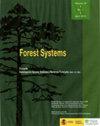A study case on polycyclic plantations (PP) as innovative models for sustainable combined production of noble hardwood and biomass
IF 0.7
4区 农林科学
Q3 FORESTRY
引用次数: 0
Abstract
Aim of study: To verify the short rotation coppices (SRC) aboveground biomass production; to define the best planting intra-row spacing for walnut and poplar growth and wood production, with the last goal to assess the possibility of obtaining competitive yields in comparison to those produced by traditional monocultures. Area of study: Po Valley, municipality of Meleti (Northern Italy). Material and methods: A randomized block design with three replications was applied for the experimental design. The growth-monitoring activities started in 2009 and have continued for 5 years on the SRC, 10 years on poplar clone ‘I-214’, whereas on common walnut they are still going on but only data concerning the twelfth year are reported in this work. The normality of distribution was evaluated for growth and yield data of species in the SRC model; all data were analysed with ANOVA; growth data were included in a linear mixed model analysis to evaluate the effect of age, spacing and their interaction, and the effect of SRC rows on growth and yield of poplar and walnut. Main results: After 5 years of cultivation under SRC system, biomass yields obtained from the poplar clone ‘AF2’ were 39.9 Mg ha-1, from the elm 31.9 Mg ha-1 and from the plane 14.8 Mg ha-1. After 10 years high timber production was obtained from poplar clone ‘I-214’ (average volume 98.2 m3 ha-1). After 12 years, walnut trees reached a diameter at breast height (DBH) of 17.8±0.2, 18.9±0.2 and 18.7±0.3 cm, respectively, for planting distances of 6, 7 and 8 m, and showed diameter increments of 1.5-2.0 cm yr-1. With these growth rates, walnut can reach a merchantable dimension within 25-30-years. Research highlights: Polycyclic wood plantations are a recent arboriculture model able to produce, on the same site, different assortments using various crop trees characterized by different growth rates and turnovers. This new type of mixed plantation is more environmentally sustainable compared to monoculture and allows diversification of production, obtaining continuous wood yields over the years (5, 10, 20, 30 years).多环人工林作为优质硬木和生物质可持续联合生产的创新模式的研究案例
研究目的:验证短轮伐矮林地上生物量产量;确定核桃和白杨生长和木材生产的最佳种植行距,最后一个目标是评估与传统单一栽培相比获得有竞争力产量的可能性。研究区域:波谷,梅莱蒂市(意大利北部)。材料和方法:实验设计采用三次重复的随机区组设计。生长监测活动始于2009年,在SRC上持续了5年,在杨树无性系“I-214”上持续了10年,而在普通核桃上仍在进行,但本工作仅报告了第十二年的数据。SRC模型中物种的生长和产量数据的分布正态性进行了评估;所有数据均采用方差分析;将生长数据纳入线性混合模型分析,以评估年龄、间距及其相互作用的影响,以及SRC行对杨树和核桃生长和产量的影响。主要结果:在SRC系统下培育5年后,杨无性系‘AF2’的生物量产量为39.9 Mg ha-1,榆树为31.9 Mg ha-1,平面为14.8 Mg ha-1。10年后,从杨无性系‘I-214’(平均体积98.2m3/ha-1)获得了高木材产量。12年后,在6、7和8m的种植距离内,核桃树的胸径分别达到17.8±0.2、18.9±0.2和18.7±0.3 cm,直径增量为1.5-2.0 cm yr-1。有了这些生长速度,核桃可以在25-30年内达到可销售的尺寸。研究亮点:多环木材种植园是一种最新的树木栽培模式,能够在同一地点使用不同的作物树木生产不同的品种,其特征是不同的生长率和周转率。与单一种植相比,这种新型的混合种植园在环境上更具可持续性,并允许生产多样化,多年来(5年、10年、20年、30年)获得持续的木材产量。
本文章由计算机程序翻译,如有差异,请以英文原文为准。
求助全文
约1分钟内获得全文
求助全文
来源期刊

Forest Systems
FORESTRY-
CiteScore
1.40
自引率
14.30%
发文量
30
审稿时长
6-12 weeks
期刊介绍:
Forest Systems is an international peer-reviewed journal. The main aim of Forest Systems is to integrate multidisciplinary research with forest management in complex systems with different social and ecological background
 求助内容:
求助内容: 应助结果提醒方式:
应助结果提醒方式:


